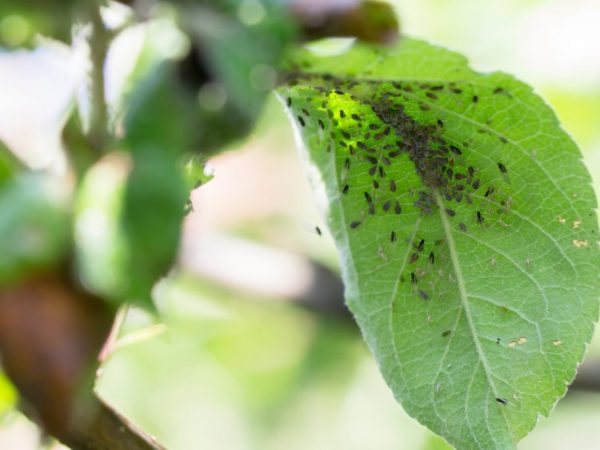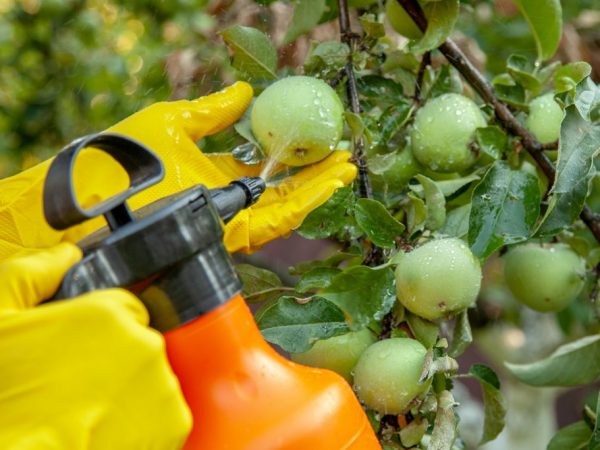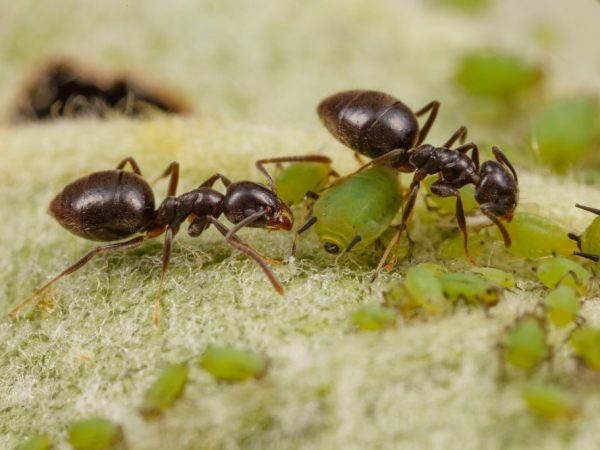Ways to combat aphids on an apple tree
Aphids on an apple tree cause a lot of trouble for gardeners. It appears more often on trees growing on soil that are poor in phosphorus, boron and magnesium with a supersaturation of nitrogen.

Ways to combat aphids on an apple tree
The main breeders of the pest are ants, which feed on their honeydew and protect the livestock from insect attacks to obtain food.
Reasons for the appearance
More often, the red-headed (blood), gallic or gray varieties of aphids are found on the apple crop. The size is no more than 0.2-0.3 cm. It lays eggs on the bark of trees, from which an individual hatches when the heat comes, and it leaves another 40-50 larvae.
Active reproduction of the pest occurs at the beginning of autumn.
Appears on plants in which the foliage juice contains a large proportion of amino acids. This is due to the lack of potassium, phosphorus, boron and magnesium, while the nitrogen content is increased at the same time. The source of the latter is chicken droppings, an excessive amount of which overloads the soil.
Primary signs and subsequent harm from aphids
With the appearance of aphids, the apple leaves begin to curl, they turn black and dry out. New growths and sticky plaque appear on them - the result of the vital activity of the pest. This leads to disruption of the process of photosynthesis, suspension in the development of young seedlings and loss of yield.
Colonies of ants flock to the honeydew secreted by aphids, which feed not only on their juice, but also encroach on apple buds and fruits.
The insect can quickly spread through the air, moving to new garden areas. Many pest species carry bacterial, viral and fungal infections. So, when a dark bloom appears on the foliage, one can judge the defeat of the sooty fungus.
Chemical methods of struggle
So that the pest does not eat all the foliage, with its massive attack on the garden culture, they resort to pesticides.
Highly toxic drugs containing carbosulfan, thiacloprid, thiamethoxam help to get rid of aphids:
- Nitrofen
- IntaVir
- Karate
- Kinmix
The first three act on adult adults and larvae. Kinmix is designed to fight during the growth of green mass
It is better to process an apple tree from aphids in early spring, before the budding stage. This makes it possible to reduce the likelihood of foliage burns and increases the effectiveness of the harmful effects of pesticides on the larvae.
There are a number of preparations of less toxic action, used including during the period of appearance of the first foliage, but before the beginning of the flowering stage.
Aphids are resistant to chemical poisons, therefore, it is recommended to alternate in treatment in order to increase the effectiveness of their action and prevent the pest from getting used to active substances.
It is enough to treat the garden culture with pesticides.The effect appears on the first day after treatment and lasts for 2-3 weeks.
To consolidate the result after 3 weeks, aphid treatment is carried out with more gentle means, they are used throughout the entire growing season of the apple tree, with an interval of 20 days. An effective remedy is "Iskra" (1 tablet per 10 liters of water).
Traditional methods

Spraying with infusions will get rid of the problem
Folk remedies help to get rid of aphids on an apple tree and at the same time to remove ants:
- traps in the form of strips (usually made of agrofibre), impregnated with a substance with a repelling odor of pests (for example, with carbolic oil infused with anise), such stripes encircle apple tree trunks in their lower part;
- onion and garlic arrows, with which they rub the trunks of young seedlings, because the smell of these crops is unpleasant for aphids and ants;
- garlic infusion - 5 cloves per 100 ml of water, insist for 1 day, add 10 g of soap and 2 tsp. vegetable oil, the resulting solution is sprayed on the apple trees;
- onion peel - 200 g per 10 liters of water, kept for 5 days and sprayed with garden culture;
- tobacco and wormwood infusions, as well as decoctions with hot pepper and celandine, they are sprayed with trees (500 g per 10 liters of water are kept for 2 days).
With the mass distribution of aphids, a highly concentrated tobacco infusion with ash and kerosene is sprayed: 200 g of makhorka, 200 g of laundry soap, 100 g of ash powder, 50 ml of kerosene.
The frequency of using folk remedies depends on the degree of damage to the garden culture and, on average, occurs every 5 days.
Root fertilizers of the garden culture with ash powder and top dressing containing ash in the composition help effectively fight aphids. They increase the level of potassium and phosphorus in the soil.
It is also permissible to spray trees with ash solutions - 200 g of ash powder per 10 liters of water, for better adhesion of the liquid to the foliage and bark of trees, 50 g of laundry soap are mixed into the solution.
When processing, special attention is paid to the underside of the leaves, where the pest prefers to settle.
Biological methods
You can fight aphids on an apple tree in other ways, without toxic effects on trees and fruits.
Aphids are eliminated by planting repellent plants and attracting their natural enemies - beneficial insects and birds - to the garden.
Scare plants
Plants are planted around the perimeter of the garden and directly near the trees, the smell of which repels the pest. These include lavender, calendula, tansy, garlic, tomatoes.
It is worth avoiding planting such plants that attract aphids - nasturtium, cosmos, poppy, viburnum, begonias, lindens.
Hanging feeders
To attract birds to the garden, feeders and birdhouses are hung up. Aphids are eaten by robin, linnet, sparrow, titmouse.
Attracting insects
The natural enemies of the pest among insects are the ladybug, lacewing, wasps, and hoverflies. They can be attracted if they are planted next to apple marigolds, fragrant herbs and nettles.
Destruction of anthills

It is necessary to get rid of ants in the area
Black ants feed on honeydew, therefore they act as defenders of the pest and protect aphids from attack by other insects.
Treatment scheme
The initial treatment of trees from pests occurs in early spring: it is permissible to use not only folk, but also chemical means.
Further control of aphids is carried out taking into account the growing stages of development of the apple tree.
June:
- in the first third, during the period when the green mass appears before flowering, preparations containing anabazine sulfate or a similar substance are permissible, they have a complex effect and create protection against most types of pests;
- in the middle of the month, preference is given to non-toxic folk remedies, solutions based on pepper and soap are effective;
- in the last third of June, trunks and skeletal branches are treated with preparations containing thiacloprid.
July:
- dwarf and young apple trees with early juices of ripening of the crop protect from the pest without the use of pesticides, for which the tips of the under-year branches are cut to the maximum;
- green leaves of winter varieties and tall trees can be treated with insecticidal agents, in which the active substances are represented by dimethoate and chlorpyrifos, which have comprehensive protection against most pests.
August:
- use mainly folk remedies because this is the ripening time for apples;
- in case of a massive pest attack, they are sprayed with sparing agents, for example, imidacloprid;
During the summer, the garden culture is also fed with superphosphate: 200 g of granules are boiled for 20 minutes in 1 liter of water.
Preventive measures
Preventive measures help prevent harmful insects from emerging:
- regular watering, proper feeding, mulching and sprinkling of the apple crown provide a dense foliage structure and its elasticity, which is difficult for aphids, as a result, it migrates to other trees;
- limiting the use of nitrogen-containing fertilizers normalizes the balance of organic compounds in the soil and vegetable juice of tree foliage, such garden crops become unattractive to the pest;
- before preserving the apple orchard for wintering near the trees, thoroughly clean the bark, under which the aphid prefers to hide for the cold season, do this with a scraper or a wire brush, separating the dead areas on the trunk and skeletal branches, while the soil under the tree is lined with a film in order to subsequently collect and destroy the peeled bark, which may contain aphid eggs and larvae.
Conclusion
Aphids on apple trees cause a reduction in yield. It is a distributor of viral, bacterial and fungal diseases, and the waste products (pad) secreted by the pest attract ants to the garden culture, eating kidneys and apples.
It appears when there is an excess of nitrogen in the soil with a simultaneous lack of potassium and phosphorus. The choice of means and measures depends on the growing stage of the apple tree development.

